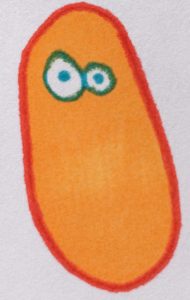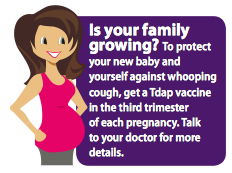 Pertussis is a highly contagious bacterial infection of the upper respiratory tract which can cause serious illness in infants, including death.
Pertussis is a highly contagious bacterial infection of the upper respiratory tract which can cause serious illness in infants, including death.
Bacteria: Bordetella pertussis (B. pertussis)
Vaccine: DTaP, Tdap
Transmission:
Pertussis (whooping cough) is very contagious and spreads easily through the air when an infected person breathes, coughs, or sneezes. Tiny droplets from an infected person’s nose or mouth become airborne and healthy person can become infected by inhaling the droplets or getting the particles on their hands and then touching their mouths or noses.
Those who have been infected with pertussis are the most contagious during the beginning of the illness and for up to two weeks after they begin to cough.
Should someone with pertussis be taking antibiotics, they tend to only be contagious for about five days after beginning antibiotic treatment.
Symptoms:
The time between infection with pertussis and the onset of symptoms is about 7-10 days, however it can be as long as 21 days before symptoms appear.
Should your child develop whooping cough, you would first notice symptoms similar to those of the common cold: Runny nose, sneezing, a dry, irritating cough, and a low-grade fever. After one to two weeks, your child may develop coughing spells, which can last for more than a minute. During these spells, your child may turn red or purple. Then, at the end of the spell, your child may make a “whooping” sound when he breathes in or may even vomit. Between spells, the child usually feels well. The recovery time for pertussis once the child has reached the whooping stage is usually a few weeks up to a few months.
Many children who get pertussis have this characteristic cough, however, not all will. Some infants do not cough, however they may seem as if they are gasping for air. Infants with pertussis may look red in the race during these spells, and may actually stop breathing for a few seconds.
Adults and teens with whooping cough may have milder symptoms. Sometimes adults have prolonged coughs rather than coughing spells, or coughing without the whooping sound. These coughing fits still can take place for 10 or more weeks. The prolonged illness can cause disruptions in school and work, and sometimes require hospitalization.
Who is at Risk:
Pertussis mainly affects infants younger than six months, before they are adequately protected by vaccination, as well as in kids between 11-18 years, when the immunity is beginning to fade. Because of waning immunity, boosters are recommended for children between ages 11-12.
Those who remain unvaccinated are at high risk of infection. About 80% of those who are not vaccinated and who come in direct contact with someone with whooping cough will become infected.1
Possible Complications:
Many cases can lead to difficulty breathing, vomiting, periods of apnea, dehydration, and disturbed sleep. Severe cases may lead to weight loss, incontinence, and rib fractures.
Up to 2 in 100 children and 5 in 100 adults with pertussis are hospitalized or have complications, which could include pneumonia or death.1

Pregnancy/Unborn Child/Newborn Risk:
It is recommended in the United States that women who are pregnant get a Tdap vaccine during the second half of ALL of their pregnancies to give their newborns important antibodies to pertussis that will last some time after birth.
Also, it is important for those who are in close contact with infants under 12 months to be vaccinated against pertussis. Babies are susceptible to severe and potentially life-threatening complications from pertussis.
Prevention:
Vaccination is recommended for all infants, children, and teens.
Currently in the United States, it is recommended that children receive five doses of the DTaP vaccine to avoid getting these three bacterial diseases. The doses are at 2 months old, 4 months old, 6 months old, between 15-18 months old, and between 4-6 years old.
Since immunity wears off to these three bacteria over time, boosters are recommended for everyone over a lifetime.
The TDaP vaccine is given in five doses to children under the ages of 7. Following this series, the tetanus and diphtheria (Td) vaccine is recommended to all individuals every ten years. A tetanus and diphtheria vaccine with a pertussis booster, called the Tdap (not to be confused with DTaP) vaccine (which has a reduced dose of the diphtheria and pertussis vaccine), is recommended to replace one of the Td boosters any time between the ages of 11 and 64. The recommendation for this Tdap booster is between the ages of 11 and 12 years of age.
The Tdap vaccine is especially important for health care professionals, anyone caring for a baby under 12 months, and pregnant women. All pregnant women are also advised to get the Tdap vaccine, preferably between 27 and 36 weeks’ gestation. Tdap should be given during EVERY pregnancy to protect the newborn from pertussis, since newborns are most at risk for life-threatening pertussis.
For those who have not been vaccinated and have come in close contact with someone with pertussis should receive antibiotics to prevent the spread of the disease. Young children who have not had all five doses of DTaP and have come in contact with someone with pertussis may need a booster dose
Treatment:
If you suspect that your child may have pertussis or have come in contact with someone who has it, call the doctor.
The doctor may take nose and throat mucus samples to be cultured for pertussis bacteria. Blood tests and chest x-rays are other possibilities for diagnosis.
Once the doctor has confirmed that your child has a case of pertussis, he will be treated with antibiotics for about 2 weeks. If given during the beginning of the illness, the antibiotics are most effective at shortening the duration of the infection. However, no matter when your child gets antibiotics, they are very important in not spreading infection to others. Family members must also be treated.
Sometimes children with pertussis must be treated in the hospital. The younger the child, the more likely they will have to be hospitalized due to the greater chance of complications. Up to 75% of infants younger than 6 months old with pertussis will receive hospital treatment because pertussis can be life-threatening in children under 6 months.1
Children recovering in the hospital often need suctioning of thick respiratory mucous. Breathing is monitored and oxygen given, if needed. Intravenous (IV) fluids might be required if a child shows signs of dehydration or has difficulty eating. Often times the child will be quarantined to protect others in the hospital from getting sick.
Parents treating their children in the home need to follow antibiotic treatment exactly as they are prescribed. It is unnecessary to give cough medication, as even the strongest of medications often will not relieve coughing spells. The cough is the body’s way to trying to clear the respiratory mucous.
Children should remain on bed rest during the worst of the infection. A cool-mist vaporizer may help soothe irritated lungs (make sure to follow directions to keep your vaporizer mold-free). Also, keep the home free of irritants such as: aerosol sprays; tobacco smoke; and smoke from cooking, fireplaces, and wood-burning stoves.
Watch for signs of dehydration, as pertussis may cause your child to vomit, or eat/drink less due to coughing. Encourage your child to eat small meals and drink plenty of fluids. The signs of dehydration include: thirst, irritability, restlessness, lethargy, sunken eyes, a dry mouth and tongue, dry skin, crying without tears, and fewer trips to the bathroom to pee (or in infants, fewer wet diapers).
Prognosis:
Pertussis usually causes prolonged symptoms: often one to two weeks of cold-like symptoms, followed by several weeks to months of severe coughing. It may take a few more weeks of recovery with gradual clearing of symptoms. Sometimes the recovery period can last for months.
Most people that come down with pertussis survive. Before the vaccine became available, pertussis killed between 5,000 and 10,000 people in the US each year.4 Due to vaccination there are less than 30 deaths in the US each year, until recently.4 By 2004, the number of pertussis cases spiked past 25,000, the highest level it’s been since the 1950s.4 Due to the increase in unvaccinated children, in 2012 there were 48,277 reported cases of pertussis and 20 deaths in the US.1
Resources:
- Centers for Disease Control and Prevention (CDC). www.cdc.gov
- Medline Plus.US National Library of Medicine. National Institutes of Health. www.nlm.nih.gov
- WebMD. www.webmd.com
- Kids Health. Nemours. www.kidshealth.org
